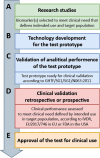Current status of development of methylation biomarkers for in vitro diagnostic IVD applications
- PMID: 32631437
- PMCID: PMC7336678
- DOI: 10.1186/s13148-020-00886-6
Current status of development of methylation biomarkers for in vitro diagnostic IVD applications
Erratum in
-
Correction to: Current status of development of methylation biomarkers for in vitro diagnostic IVD applications.Clin Epigenetics. 2020 Jul 14;12(1):107. doi: 10.1186/s13148-020-00902-9. Clin Epigenetics. 2020. PMID: 32665014 Free PMC article.
Abstract
A significant volume of research clearly shows that disease-related methylation changes can be used as biomarkers at all stages of clinical disease management, including risk assessment and predisposition screening through early diagnostics to personalization of patient care and monitoring of the relapse and chronic disease. Thus disease-related methylation changes are an attractive source of the biomarkers that can have significant impact on precision medicine. However, the translation of the research findings in methylation biomarkers field to clinical practice is at the very least not satisfactory. That is mainly because the evidence generated in research studies indicating the utility of the disease-related methylation change to predict clinical outcome is in majority of the cases not sufficient to postulate the diagnostic use of the biomarker. The research studies need to be followed by well-designed and systematic investigations of clinical utility of the biomarker that produce data of sufficient quality to meet regulatory approval for the test to be used to make clinically valid decision. In this review, we describe methylation-based IVD tests currently approved for IVD use or at the advanced stages of the development for the diagnostic use. For each of those tests, we analyze the technologies that the test utilizes for methylation detection as well as describe the types of the clinical studies that were performed to show clinical validity of the test and warrant regulatory approval. The examples reviewed here should help with planning of clinical investigations and delivery of the clinical evidence required for the regulatory approval of potential methylation biomarker based IVD tests.
Keywords: Biomarker; DNA methylation; Epigenetics; IVD; In Vitro diagnostics.
Conflict of interest statement
The authors declare that they have no competing interests.
Figures
References
Publication types
MeSH terms
Substances
LinkOut - more resources
Full Text Sources
Other Literature Sources
Medical


